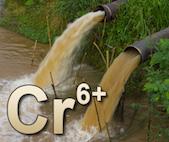Hexavalent Chromium

Research Overview
Status: Completed
Substances:
Sodium dichromate dihydrate (VI)
Nominated:
October 2000
Findings:
TOX-72
(12.53 MB), TR-546
(2.47 MB)
Background Information
Hexavalent chromium is an established human carcinogen in certain occupational settings as a result of inhalation exposure. Hexavalent chromium compounds have been found in drinking water. The long-term consequences of exposure to these compounds in drinking water sources were uncertain.
The element chromium occurs naturally in various states, including trivalent chromium which is an essential nutrient. However, hexavalent chromium is rare in nature. Environmental hexavalent chromium is usually man-made and associated with industrial sources, setting it apart from other types of chromium as a subject of study.
In 2000 and 2001, NTP received the following nominations from California officials to study the toxicity and carcinogenicity of hexavalent chromium in drinking water:
- Nomination from California State Senator Adam Schiff
- Nomination from California EPA
- Nomination from US Congressional Delegation from California
As a result of these nominations, NTP studied the short-term toxicity and long-term carcinogenicity of sodium dichromate dihydrate, a hexavalent chromium compound, administered to rodents in drinking water. NTP found that sodium dichromate dihydrate in the drinking water caused oral cancer in rats and small intestine cancer in mice.
NTP's work on hexavalent chromium has informed research and decision making for various stakeholders, including federal agencies, state agencies, and academia. The results of NTP’s two-year toxicity and carcinogenicity studies on a hexavalent chromium compound (NTP TR 546) were cited in the initial statement to adopt a maximum contaminant level for hexavalent chromium in drinking water in California. The NTP impact analysis was published in February 2017.
NTP Studies & Findings
After receiving nominations in 2000-2001 to study the safety of hexavalent chromium in drinking water, NTP began preliminary studies and designed long-term, two-year studies. For a full list of studies, see the NTP testing status page for sodium dichromate dihydrate, a hexavalent chromium compound.
In July 2002, NTP held a meeting to receive input from a panel of scientific experts and the public about data available from preliminary studies on hexavalent chromium. The discussion also focused on the design of proposed laboratory toxicity and carcinogenicity studies of hexavalent chromium administered in drinking water to rodents. The expert panel noted that NTP's studies were well designed and provided recommendations on some elements for improvement.
In 2007, NTP published the results of the short-term, three-month toxicity studies (TOX-72) on a hexavalent chromium compound. NTP reported that exposure to sodium dichromate dihydrate caused increased tissue growth and ulcers in the stomach of rats. NTP also found low blood count and lesions of the small intestine in rats and mice. The lesions of the small intestine are potentially symptoms of the initial stage of cancer.
In 2008, NTP published the results of the two-year toxicity and carcinogenicity studies (TR-546) on a hexavalent chromium compound. NTP reported that sodium dichromate dihydrate in drinking water caused oral cancer in rats and small intestine cancer in mice. NTP's results and conclusions from the three-month and two-year studies were peer reviewed by external experts.
Research at Other Agencies
United States
- California
Chromium-6 Drinking Water MCL - New Jersey
New Jersey Department of Environmental Protection: Chromium Workgroup - US Centers for Disease Control and Prevention, National Institute for Occupational Safety and Health
Workplace Safety and Health Topics: Hexavalent Chromium - US Environmental Protection Agency
Integrated Risk Information System: Chromium (VI) - US Occupational Safety and Health Administration
Safety and Health Topics: Hexavalent Chromium
International
- International Agency for Research on Cancer, 2012
Chromium (VI) Compounds - International Programme on Chemical Safety, 2013
Concise International Chemical Assessment Document 78: Inorganic Chromium (VI) Compounds
Informational Resources
NIEHS Health Topic
Publications
- Shipkowski KA, Sheth CM, Smith MJ, Hooth MJ, White KL Jr, Germolec DR. Assessment of immunotoxicity in female Fischer 344/N and Sprague Dawley rats and female B6C3F1 mice exposed to hexavalent chromium via the drinking water. Journal of Immunotoxicology. 2017;14(1):215-227.
- Xie Y, Holmgren S, Andrews DMK, Wolfe MS. Evaluating the impact of the U.S. National Toxicology Program: a case study on hexavalent chromium. Environ Health Perspectives. 2017;125:181–188.
- Witt KL, Stout MD, Herbert RA, Travlos GS, Kissling GE, Collins BJ, et al. Mechanistic insights from the NTP studies of chromium. Toxicol Pathol. 2013 Feb;41(2):326–42.
- Collins BJ, Stout MD, Levine KE, Kissling GE, Melnick RL, Fennell TR, et al. Exposure to hexavalent chromium resulted in significantly higher tissue chromium burden compared with trivalent chromium following similar oral doses to male F344/N rats and female B6C3F1 mice. Toxicol Sci. 2010 Dec;118(2):368–79.
- Levine KE, Stout MD, Ross GT, Essader AS, Weber FX, Grohse PM, et al. Validation and application of a method for the determination of total chromium in rat tissues by inductively coupled plasma mass spectrometry. Arch Environ Contam Toxicol. 2010 Apr;58(3):883–91.
- Levine KE, Stout MD, Ross GT, Essader AS, Perlmutter JM, Grohse PM, et al. Validation of a method for the determination of total chromium in rat feces by inductively coupled plasma optical emission spectrometry. Analytical Letters. 2009;42(17):2729–2746.
- Stout MD, Herbert RA, Kissling GE, Collins BJ, Travlos GS, Witt KL, et al. Hexavalent chromium is carcinogenic to F344/N rats and B6C3F1 mice after chronic oral exposure. Environ Health Perspect. 2009 May;117(5):716–22
Other NTP Evaluations
Chromium Hexavalent Compounds
View the Chromium Hexavalent Compounds listing in the 15th Report on Carcinogens (2021).
Reproductive Toxicity of Potassium Dichromate in Diet to Rodents
Learn more about NTP studies on potassium dichromate (CASRN 778-50-9):
- Abstract from RACB94014: Administered to BALB/c Mice, 1997
- Abstract from RACB95002: Administered to BALB/c Mice, 1996
- Abstract from RACB95001: Administered to SD Rats, 1996
Stay Informed & Contact Us

Stay Informed
Subscribe to receive email to stay informed about hexavalent chromium research and other NTP information.
Contact Us
For questions or additional information, email us or use our contact form.

